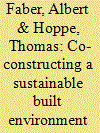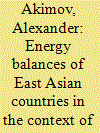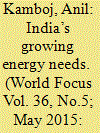|
|
|
Sort Order |
|
|
|
Items / Page
|
|
|
|
|
|
|
| Srl | Item |
| 1 |
ID:
180860


|
|
|
|
|
| Summary/Abstract |
This paper explores the history of wind power technologies and the integration of wind energy in the Danish energy system. It does so focusing particularly on historical events, socio-cultural and socio-political changes and priorities that were important on this technological journey. From the first primitive wind turbines in the late 1800s, to the world wars, through the energy- crisis in the 70s, and into the decades of growing environmental awareness and concern, this historical account describes how policy priorities in Denmark gradually translated from the focus on energy diversification, energy efficiency and energy independence to the focus on sustainability and renewable energy resources, with wind energy and wind power technologies at the top of the priority list. Historically, wind power has been - and it still is - popular in Denmark. However, as the modern wind power turbines gradually grew to industrial scale heights, unchallenged support for specific local wind farms could no longer be taken for granted. This paper also touches upon the frequently tacit dilemmas of renewable energy technology planning and deployment, for example issues of environmental justice, wind farm ownership structures, and the role of social psychology for low-carbon energy transition processes. Notably, attention is drawn to the representation biases that may result in the emphasis of wind farm opposition / grievances in the wider wind farm related debates, where resistance to local wind farm projects might derive from minority opposition groups. Insights and lessons learnt from this Danish history of wind power may prove valuable and inspirational for other countries engaging in low-carbon energy transitions.
|
|
|
|
|
|
|
|
|
|
|
|
|
|
|
|
| 2 |
ID:
122813


|
|
|
| 3 |
ID:
117275


|
|
|
|
|
| Publication |
2013.
|
| Summary/Abstract |
There is considerable scope for energy efficiency improvements to the housing stock in the Netherlands. Although, economically, there are many technological opportunities available, the Dutch built environment has difficulty to harvest this potential. This paper applies a sectoral innovation system approach to investigate this apparent paradox. This approach allows to identify and assess systemic barriers that prevent improvement in overall energy efficiency of the Dutch housing sector. Twenty-one experts were interviewed, and a qualitative data analysis was applied to identify barriers, and relate them to key dimensions in the sectoral innovation system framework. From this analysis, we identified poor regulatory design, lack of market demand, and some institutional characteristics of the construction sector as the key systemic barriers that hamper the diffusion of green energy innovations in the Dutch housing sector.
|
|
|
|
|
|
|
|
|
|
|
|
|
|
|
|
| 4 |
ID:
181410


|
|
|
|
|
| Summary/Abstract |
The four developed East Asian economies - the People's Republic of China, Japan, the Republic of Korea, and Taiwan - form a major global center for fuel and energy consumption, with very limited reserves of fossil fuels other than coal in the People's Republic of China. The energy balances of these countries are similar in terms of a significant share of imports, including high-tech imports of liquefied natural gas, as well as a high share of coal. All these countries use modern technologies, including nuclear power and renewable energy sources, but the policies of these countries in focusing on modern technologies differ.
|
|
|
|
|
|
|
|
|
|
|
|
|
|
|
|
| 5 |
ID:
094869


|
|
|
|
|
| Publication |
2010.
|
| Summary/Abstract |
This paper focuses on energy system development of the three largest Association of South East Asian Nations (ASEAN) countries: Indonesia, Philippines and Vietnam. The energy infrastructures in these counties are in the process of rapid development and, therefore, technology choices are critical. Applying the energy system model MARKAL and scenario analysis, this paper examines and quantifies the role of clean and advanced energy technologies for efficient local resource exploitation and improving energy security and environmental conditions. The main focus is on the power sector and the paper also addresses the potential ASEAN markets for European energy technologies.
The paper concludes that there is a large potential market for clean and advanced energy technologies in the studied countries. If adopted, these technologies will bring several benefits like reduction in primary energy requirement, reduced investments requirement in the power sector and other parts of the energy infrastructure, reduced import of primary energy, reduced CO2 emissions and local pollution, reduced energy system costs and marginal cost of electricity supply. Finally, barriers for transfer and diffusion of advanced energy technologies are discussed.
|
|
|
|
|
|
|
|
|
|
|
|
|
|
|
|
| 6 |
ID:
138382


|
|
|
|
|
| Summary/Abstract |
Today, India has the fifth largest installed capacity worldwide for electricity. India’s energy mix is dependent mainly on coal, oil and gas which are the source of more than 70% power generation, most of which is imported. With this dependence expected to increase, the country needs assured access to imported energy supplies in addition to new energy related technologies. Towards this, the government needs to promote economic partnership with countries that have energy resources and technologies.
|
|
|
|
|
|
|
|
|
|
|
|
|
|
|
|
| 7 |
ID:
122888


|
|
|
| 8 |
ID:
127866


|
|
|
|
|
| Publication |
2014.
|
| Summary/Abstract |
We use panel cointegration techniques to examine the relationship between renewable energy consumption, trade and output in a sample of 11 African countries covering the period 1980-2008. The results from panel error correction model reveal that there is evidence of a bidirectional causality between output and exports and between output and imports in both the short and long-run. However, in the short-run, there is no evidence of causality between output and renewable energy consumption and between trade (exports or imports) and renewable energy consumption. Also, in the long-run, there is no causality running from output or trade to renewable energy. In the long-run, our estimations show that renewable energy consumption and trade have a statistically significant and positive impact on output. Our energy policy recommendations are that national authorities should design appropriate fiscal incentives to encourage the use of renewable energies, create more regional economic integration for renewable energy technologies, and encourage trade openness because of its positive impact on technology transfer and on output.
|
|
|
|
|
|
|
|
|
|
|
|
|
|
|
|
| 9 |
ID:
149997


|
|
|
|
|
| Summary/Abstract |
It is important for policy makers to have an accurate understanding of public attitudes toward pressing issues to help inform their decision making. Researchers consistently find that the public’s receipt of and correct processing of scientific information and knowledge are essential for its problem solving. Different levels of understanding of specific energy technologies may produce different risk assessments across technologies within this issue domain. How this differential risk assessment occurs and the role that scientific information may play in it is not yet well known. This project seeks to determine the role that perceived and objective scientific knowledge may play in the public’s risk assessments of different energy technologies. Our findings suggest that scientific knowledge does temper public risk evaluations of different energy technologies, therefore linking more clearly the connection between science knowledge, scientific trust, and issue problem identification.
|
|
|
|
|
|
|
|
|
|
|
|
|
|
|
|
| 10 |
ID:
127867


|
|
|
|
|
| Publication |
2014.
|
| Summary/Abstract |
From a biophysical perspective, woody biomass resources are large enough to cover a substantial share of the world's primary energy consumption in 2050. However, these resources have alternative uses and their accessibility is limited, which tends to decrease their competitiveness with respect to other forms of energy. Hence, the key question of woody biomass use for energy is not the amount of resources, but rather their price. In this study we consider the question from the perspective of energy wood supply curves, which display the available amount of woody biomass for large-scale energy production at various hypothetical energy wood prices. These curves are estimated by the Global Biosphere Management Model (GLOBIOM), which is a global partial equilibrium model of forest and agricultural sectors. The global energy wood supply is estimated to be 0-23 Gm3/year (0-165 EJ/year) when energy wood prices vary in a range of 0-30$/GJ (0-216$/m3). If we add household fuelwood to energy wood, then woody biomass could satisfy 2-18% of world primary energy consumption in 2050. If primary forests are excluded from wood supply then the potential decreases up to 25%.
|
|
|
|
|
|
|
|
|
|
|
|
|
|
|
|
|
|
|
|
|